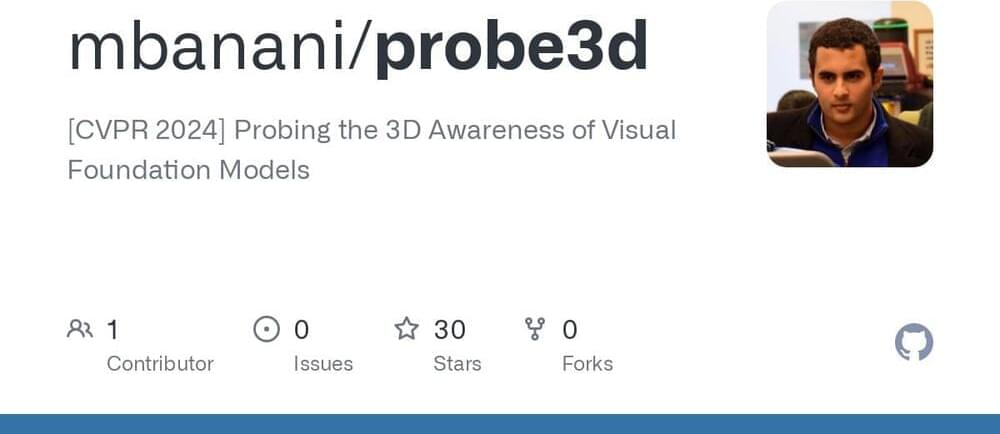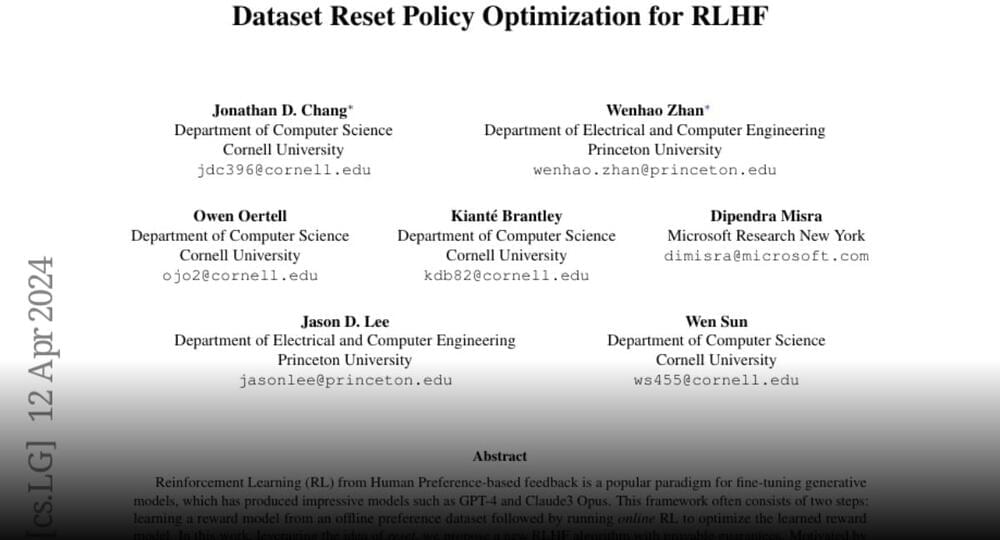Should We Send Messages into Space to be Received by Aliens? And would they be able to decode them? Posted on BigThink, link from my website:


Battery–electric vehicles have become ubiquitous as more people have realized how much less pollution they produce than traditional gas-powered cars. But another type of planet-friendly vehicle, the hydrogen car, has yet to catch on, for a few different reasons.
Now, a new technique developed by researchers at Rice University in Texas may provide the key to making hydrogen cars — and hydrogen fuel as a whole — more viable.
Hydrogen is incredibly attractive as an alternative to gas and oil — it is a storable fuel that produces no planet-overheating pollution when used. The problem, however, is that it produces a whole lot of planet-overheating pollution when it is made.

This repository contains a re-implementation of the code for the paper Probing the 3D Awareness of Visual Foundation Models (CVPR 2024) which presents an analysis of the 3D awareness of visual foundation models.
Mohamed El Banani, Amit Raj, Kevis-Kokitsi Maninis, Abhishek Kar, Yuanzhen Li, Michael Rubinstein, Deqing Sun, Leonidas Guibas, Justin Johnson, Varun Jampani
If you find this code useful, please consider citing:

A new hypothesis paper appearing in the Journal of Parkinson’s Disease on World Parkinson’s Day unites the brain-and body-first models with some of the likely causes of the disease–environmental toxicants that are either inhaled or ingested.
Pointing to a growing body of research linking environmental exposure to Parkinson’s disease, the authors believe the new models may enable the scientific community to connect specific exposures to specific forms of the disease. This effort will be aided by increasing public awareness of the adverse health effects of many chemicals in our environment. The authors conclude that their hypothesis “may explain many of the mysteries of Parkinson’s disease and open the door toward the ultimate goal–prevention.”
In addition to Parkinson’s, these models of environmental exposure may advance understanding of how toxicants contribute to other brain disorders, including autism in children, ALS in adults, and Alzheimer’s in seniors. Dorsey and his colleagues at the University of Rochester have organized a symposium on the Brain and the Environment in Washington, DC, on May 20 that will examine the role toxicants in our food, water, and air are playing in all these brain diseases.
Additional authors of the hypothesis paper include Briana De Miranda, PhD, with the University of Alabama at Birmingham, and Jacob Horsager, MD, PhD, with Aarhus University Hospital in Denmark.

From Cornell, Princeton, & Microsoft.
Dataset Reset Policy Optimization for RLHF https://huggingface.co/papers/2404.
Reinforcement Learning (RL) from Human Preference-based feedback is a popular paradigm for fine-tuning generative models, which has produced impressive models such as GPT-4 and…
Join the discussion on this paper page.

When you study science, and especially these realms of the biology of what makes us human, what’s clear is that every time you find out something, that brings up ten new questions, and half of those are better questions than you started with.
The artistic masterpiece above, reminiscent of a stained glass window, is the work of Michael Angelo—no, not the famous 16th Century Italian artist, but a 21st Century physician-scientist who’s out to develop a better way of looking at what’s going on inside solid tumors. Called multiplexed ion beam imaging (MIBI), Angelo’s experimental method may someday give clinicians the power to analyze up to 100 different proteins in a single tumor sample.
In this image, Angelo used MIBI to analyze a human breast tumor sample for nine proteins simultaneously—each protein stained with an antibody tagged with a metal reporter. Six of the nine proteins are illustrated here. The subpopulation of cells that are positive for three proteins often used to guide breast cancer treatment (estrogen receptor a, progesterone receptor, Ki-67) have yellow nuclei, while aqua marks the nuclei of another group of cells that’s positive for only two of the proteins (estrogen receptor a, progesterone receptor). In the membrane and cytoplasmic regions of the cell, red indicates actin, blue indicates vimentin, which is a protein associated with highly aggressive tumors, and the green is E-cadherin, which is expressed at lower levels in rapidly growing tumors than in less aggressive ones.

Now impacting All Life on Earth.
It’s not the first study on microplastics in Antarctica that researchers from the University of Basel and the Alfred-Wegener Institute (AWI) have conducted. However, data analysis from a spring 2021 expedition reveals that environmental pollution from these tiny plastic particles is a bigger problem in the remote Weddell Sea than was previously known.
The total of 17 seawater samples all indicated higher concentrations of microplastics than in previous studies. “The reason for this is the type of sampling we conducted,” says Clara Leistenschneider, doctoral candidate in the Department of Environmental Sciences at the University of Basel and lead author of the study.
The current study focused on particles measuring between 11 and 500 micrometers in size. The researchers collected them by pumping water into tanks, filtering it, and then analyzing it using infrared spectroscopy. Previous studies in the region had mostly collected microplastic particles out of the ocean using fine nets with a mesh size of around 300 micrometers. Smaller particles would simply pass through these plankton nets.

The effort to give robots AI brains is revealing big practical challenges—and bigger ethical concerns.

Artificial intelligence startup Symbolica AI launched today with an original approach to building generative AI models.
The company is aiming to tackle the expensive mechanisms behind training and deploying large language models such as OpenAI’s ChatGPT that are based on Transformer architecture.
Alongside that news, it also revealed today that it has raised $33 million in total funding combined from a Series A and seed funding round led by Khosla Ventures. Other investors included Day One Ventures, Abstract Ventures Buckley Ventures and General Catalyst.

Fascinating vision/plan by the one and only Sam Altman of how to update our economic systems to benefit everyone in the context of rapidly accelerating technological change.
My work at OpenAI reminds me every day about the magnitude of the socioeconomic change that is coming sooner than most people believe. Software that can think and learn will do more and more of the work that people now do. Even more power will shift from labor to capital. If public policy doesn’t adapt accordingly, most people will end up worse off than they are today.
We need to design a system that embraces this technological future and taxes the assets that will make up most of the value in that world–companies and land–in order to fairly distribute some of the coming wealth. Doing so can make the society of the future much less divisive and enable everyone to participate in its gains.
In the next five years, computer programs that can think will read legal documents and give medical advice. In the next decade, they will do assembly-line work and maybe even become companions. And in the decades after that, they will do almost everything, including making new scientific discoveries that will expand our concept of “everything.”